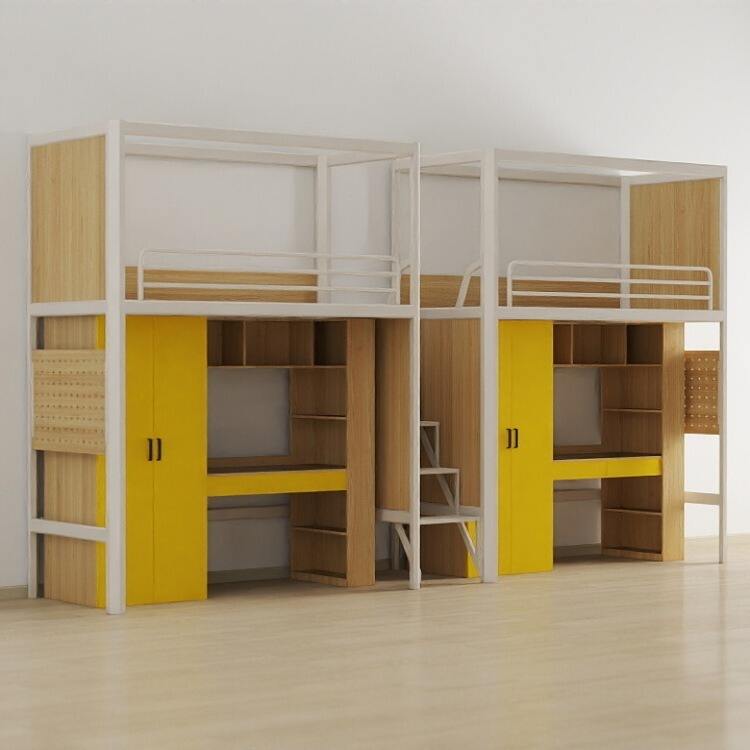Maximizing Living Space Through Smart Storage Solutions
Living in compact urban spaces requires innovative thinking when it comes to storage and furniture. Modern apartment dwellers increasingly seek solutions that combine functionality with style, making wall cupboards an essential element in small living spaces. The challenge lies in creating storage that doesn't overwhelm the room while providing maximum utility. Whether you're looking to install a murphy-style apartment bed or build custom cabinets, understanding the principles of space-saving design is crucial.
Essential Design Principles for Wall Storage
Vertical Space Utilization
Making the most of vertical space is fundamental when designing wall cupboards for small apartments. Floor-to-ceiling storage maximizes every inch of available wall area while creating a seamless, built-in look. Consider incorporating an apartment bed system that folds into the wall, surrounded by storage compartments. This approach not only saves precious floor space but also creates a cohesive design element that serves multiple purposes.
When planning vertical storage, account for accessibility and ease of use. The most frequently accessed items should be stored at eye level, while seasonal items can be placed in higher compartments. Installing pull-down hanging rods or retractable shelves can make upper storage areas more accessible without requiring a step stool.
Modular Components and Flexibility
Modular design allows for customization and adaptation as needs change. Start with a basic framework that can accommodate various insert options - from drawers and shelves to fold-out desks and apartment bed mechanisms. This flexibility ensures the storage system remains useful even as living situations evolve.
Consider incorporating adjustable shelving systems that can be reconfigured seasonally or as storage needs change. Removable drawer units, sliding panels, and interchangeable components add versatility to your wall storage solution while maintaining a clean, organized appearance.
Smart Materials Selection and Construction
Durability and Weight Considerations
The success of wall-mounted storage depends heavily on material selection. For units incorporating an apartment bed, structural integrity is paramount. High-grade plywood or engineered wood products offer excellent strength-to-weight ratios and resist warping. Metal components, particularly for bed mechanisms and heavy-duty hinges, should be steel or aluminum for longevity.
Consider the wall's load-bearing capacity when designing built-in storage. Professional installation may be necessary for heavier components, ensuring proper mounting and safety. Use reinforced mounting brackets and adequate wall anchors to support the weight of stored items and any mechanical elements.
Surface Finishes and Aesthetics
Choose materials and finishes that complement your apartment's existing décor while maintaining practicality. Melamine-faced boards offer durability and easy cleaning, while wood veneers provide a more luxurious appearance. For areas around an apartment bed installation, consider using scratch-resistant laminates that can withstand daily use.
Light-colored finishes can help reflect light and create the illusion of more space, while textured surfaces add visual interest without overwhelming the room. Consider mixing materials - such as glass panels for display areas and solid panels for concealed storage - to create visual variety while maintaining functionality.
Innovative Storage Features
Multi-functional Elements
Modern wall storage should incorporate multi-purpose features. Consider integrating a fold-down desk near the apartment bed area, creating a home office that disappears when not in use. Pull-out nightstands, integrated lighting, and charging stations add functionality without consuming additional space.
Hidden storage compartments behind panels or inside larger cabinets can house seasonal items or rarely used possessions. Consider installing mirrors on cabinet doors to serve both practical and aesthetic purposes, making the room appear larger while providing a necessary function.
Space-Optimizing Hardware
The right hardware can dramatically improve storage efficiency. Soft-close mechanisms prevent slamming and protect cabinet longevity, while push-to-open latches eliminate the need for handles, creating a sleeker appearance. For apartment bed installations, high-quality gas struts ensure smooth operation and safety.
Consider incorporating LED lighting strips in strategic locations to illuminate storage areas and create ambiance. Motion-sensor lights inside cabinets make it easier to locate items, while integrated bed lighting provides convenient reading light without requiring additional fixtures.
Professional Planning and Installation Tips
Measurement and Layout
Precise measurements are crucial for successful wall storage implementation. Account for baseboards, crown molding, and any architectural features that might affect installation. Create detailed drawings showing both the exterior appearance and internal organization of storage components, including specific dimensions for the apartment bed mechanism if included.
Consider traffic flow and door swing radiuses when planning layout. Ensure adequate clearance for comfortable movement and accessibility to all storage areas. Factor in window locations and natural light patterns to optimize the placement of different storage elements.
Future Maintenance Considerations
Design your storage system with maintenance in mind. Include removable panels for access to plumbing or electrical systems behind cabinets. Plan for regular cleaning by avoiding deep recesses that collect dust and choosing easy-to-clean surfaces.
Consider the longevity of mechanical components, particularly for apartment bed mechanisms. Choose systems with readily available replacement parts and establish maintenance schedules for moving parts to ensure long-term reliability.
Frequently Asked Questions
What is the ideal height for wall-mounted storage in a small apartment?
The optimal height for wall-mounted storage extends from floor to ceiling, typically 8-9 feet. However, the most accessible storage zone should be between 3-6 feet from the floor, with less frequently used items stored higher up. When incorporating an apartment bed, ensure the mechanism is installed at a comfortable operating height.
How much weight can wall-mounted cabinets typically support?
Weight capacity depends on wall construction and mounting methods. Properly installed cabinets in studs can support 100-300 pounds per linear foot. However, when including an apartment bed system, professional installation is essential as these can require support for 500+ pounds.
What are the best materials for long-lasting wall storage?
High-grade plywood, MDF with quality laminate, and hardwood are excellent choices for longevity. Metal components should be steel or aluminum with proper protective coatings. For areas around an apartment bed, choose materials rated for heavy use and repeated mechanical operation.
How much clearance is needed for a wall-mounted storage system?
Standard wall cabinets require 12-24 inches of depth, depending on their purpose. For systems including an apartment bed, plan for at least 16 inches when closed and ensure adequate clearance (typically 80-85 inches) when the bed is deployed. Always add a few inches of buffer space for ease of use.


